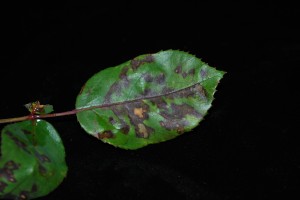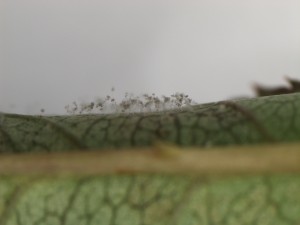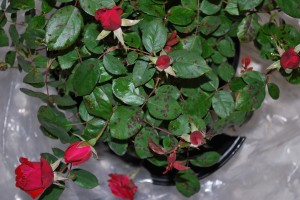Downy mildew was identified in Knock Out® rose samples submitted to the Plant Diagnostic Lab from a south-Jersey nursery this week. Knock Outs®, which have few problems, have been a favorite in New Jersey landscapes in recent years. Unfortunately, it seems this plant has met its Achilles’ heel.
Downy mildew manifests itself as red or purplish, angular leaf spots that turn tan in the center. Infected leaves drop so the plants are aesthetically unappealing or unsalable. Peronospora sparsa, the fungus-like organism that causes downy mildew, will rapidly infect susceptible plants during cool, wet weather and is very active during a typical New Jersey spring. The fungus can also wreak havoc in hoop houses or other production facilities with tight plant spacing and overhead irrigation.

Reddish-purple angular leaf lesions typical of downy mildew on rose. Photo: Sabrina Tirpak, Rutgers PDL
Interestingly enough, P. sparsa carries the specific epithet “sparsa” because the fungus is barely visible on the undersides of infected leaves. In the laboratory, we incubate suspect leaves in a high humidity chamber. After several days a thin, gray, fuzzy mass (the sporangiophores = spore making stalks) appears on the bottoms of the leaves, which allows for a proper diagnosis.

Peronospora sparsa sporulates on the undersides of infected leaves. Photo: Sabrina Tirpak, Rutgers PDL
More information on roses and downy mildew try this link.


